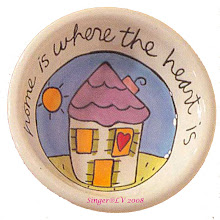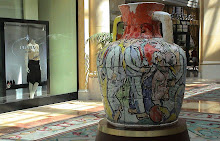【晚禱】油彩、帆布/1857-1859年/55.5x66公分米勒以童年回憶為藍本,描繪在馬鈴薯田工作的一對農夫農婦,聽到遠方傳來的教堂晚禱鐘聲,放下手邊的農務,在暮色中低首祈禱的肅穆身影。簡潔有力的刻畫,讓「晚禱」超越宗教的意涵,以謙卑、感恩、尊敬土地的普世價值引起共鳴。圖/法國奧塞美術館
 Millet_The Gleaners 拾穗, 1857_Musee du Louvre,Paris
Millet_The Gleaners 拾穗, 1857_Musee du Louvre,Paris 【拾穗】油彩、帆布/1857年/83.55x110公分「拾穗」源自舊約聖經,意指在秋收季節,農夫須允許窮人在收割過後的田地,撿拾剩餘的麥穗、玉米穗等,以求溫飽。米勒筆下的「拾穗」,描繪三位無名農婦,沐浴在金黃秋陽下,曲背彎腰拾取地上的麥穗,畫面散發英雄史詩般的崇高意境。圖/法國奧塞美術館
米勒曠世名作名作「晚禱」、「拾穗」,將來台展出
【資料來源:民視新聞、三立新聞、中央廣播電台2008/01/23】
田園畫家米勒的兩幅曠世名作「晚禱」和「拾穗」,今年5月將在國立歷史博物館現身。歷史博物館的年度大展「驚艷米勒:田園之美畫展」,共展出16幅米勒的作品,其中的「晚禱」和「拾穗」更是巴黎奧塞美術館的鎮館之寶,這兩幅畫從來不曾同時借展海外,這次專程來台借展。主辦單位也為單幅畫作,各投保1億歐元的天價。
「驚艷米勒:田園之美畫展」共展出70幅自然畫派的作品,其中米勒的畫作有16幅,國立歷史博物館長黃永川指出,奧塞美術館收有米勒19幅畫作,來台借展的就有16幅,民眾不必遠渡重洋,都能一賭大師的藝術生涯。而這次展覽最值得一提的是,米勒的「晚禱」和「拾穗」首次同時來台借展。
黃永川說,這兩幅畫作由於是鎮館之寶,因此從不同時借展,但這次因為奧塞美術館整修展廳,才破天荒同時來台。也由於機會難得,因此借展費用還傳出高達100萬歐元。黃永川表示,這次展覽籌劃1年,奧塞美術館還特別在2個月前派專人來台勘查。主辦單位也為珍貴畫作投保天價保險金。他說:『像日本其他國家一定非常羡慕,因為它來台灣展完就回去了,特別為台灣、保險價值每一件都是1億歐元,光是那兩幅畫等於就將近(新台幣)90億了。』
史博館在1997年曾經舉辦「黃金印象:奧塞美術館名作特展」,3個月的展期,共吸引4、50萬人次;2008年的「驚艷米勒:田園之美畫展」,展期自5月31號到9月5號,館方預計將為台灣藝壇興起一片高潮。
米勒曠世名作名作「晚禱」、「拾穗」,將來台展出
【資料來源:民視新聞、三立新聞、中央廣播電台2008/01/23】
田園畫家米勒的兩幅曠世名作「晚禱」和「拾穗」,今年5月將在國立歷史博物館現身。歷史博物館的年度大展「驚艷米勒:田園之美畫展」,共展出16幅米勒的作品,其中的「晚禱」和「拾穗」更是巴黎奧塞美術館的鎮館之寶,這兩幅畫從來不曾同時借展海外,這次專程來台借展。主辦單位也為單幅畫作,各投保1億歐元的天價。
「驚艷米勒:田園之美畫展」共展出70幅自然畫派的作品,其中米勒的畫作有16幅,國立歷史博物館長黃永川指出,奧塞美術館收有米勒19幅畫作,來台借展的就有16幅,民眾不必遠渡重洋,都能一賭大師的藝術生涯。而這次展覽最值得一提的是,米勒的「晚禱」和「拾穗」首次同時來台借展。
黃永川說,這兩幅畫作由於是鎮館之寶,因此從不同時借展,但這次因為奧塞美術館整修展廳,才破天荒同時來台。也由於機會難得,因此借展費用還傳出高達100萬歐元。黃永川表示,這次展覽籌劃1年,奧塞美術館還特別在2個月前派專人來台勘查。主辦單位也為珍貴畫作投保天價保險金。他說:『像日本其他國家一定非常羡慕,因為它來台灣展完就回去了,特別為台灣、保險價值每一件都是1億歐元,光是那兩幅畫等於就將近(新台幣)90億了。』
史博館在1997年曾經舉辦「黃金印象:奧塞美術館名作特展」,3個月的展期,共吸引4、50萬人次;2008年的「驚艷米勒:田園之美畫展」,展期自5月31號到9月5號,館方預計將為台灣藝壇興起一片高潮。
Jean Francois Millet (1814-1875)
Jean Francois Millet was born into a family of peasant farmers near Cherbourg. He trained locally as a painter and then went to Paris in 1837 to study under Delaroche. His early work comprised of conventional portraits and fashionable eighteenth century pastoral scenes. However, in 1848 he chose to exhibit The Winnower, a painting depicting peasant life, at the Paris Salon. It was the first of many rural scenes based on memories of his own childhood. Criticized for allowing socialist concerns to infiltrate his art, Millet stated that it was "the human side" of life that he wished to portray, In 1849 he moved to Barbizon where he remained for the rest of his life, painting labourers going about their daily business. In The Angelus, his best known work, Millet chose to celebrate a dignified, hard working couple at work in the fields - their heads bowed in an expression of devotion in the face of nature. Depicting his human figures with a classically sculptural simplicity, Millet's concern was to show the pair in harmony with their peaceful and unchanging rural existence.
Jean Francois Millet was born into a family of peasant farmers near Cherbourg. He trained locally as a painter and then went to Paris in 1837 to study under Delaroche. His early work comprised of conventional portraits and fashionable eighteenth century pastoral scenes. However, in 1848 he chose to exhibit The Winnower, a painting depicting peasant life, at the Paris Salon. It was the first of many rural scenes based on memories of his own childhood. Criticized for allowing socialist concerns to infiltrate his art, Millet stated that it was "the human side" of life that he wished to portray, In 1849 he moved to Barbizon where he remained for the rest of his life, painting labourers going about their daily business. In The Angelus, his best known work, Millet chose to celebrate a dignified, hard working couple at work in the fields - their heads bowed in an expression of devotion in the face of nature. Depicting his human figures with a classically sculptural simplicity, Millet's concern was to show the pair in harmony with their peaceful and unchanging rural existence.






















沒有留言:
張貼留言